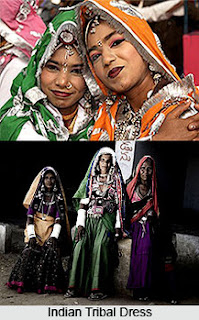Indian tribal fashion is a celebration of vibrant
colors, intricate designs, and deep-rooted cultural heritage. Each tribal
community across the Indian subcontinent boasts its unique sartorial
traditions, reflecting a rich tapestry of history, environment, and social
practices. This article explores the diverse and captivating world of tribal
fashion in India, highlighting its significance, distinctiveness, and
contemporary relevance.
India's tribal fashion is as varied as
its tribes. From the arid deserts of Rajasthan to the lush forests of the
Northeast, tribal attire represents a symbiosis between environment and
culture. For instance, the attire of the Bhil tribe of Gujarat and Rajasthan is
characterized by bold, geometric patterns and bright colors, often adorned with
mirror work and embroidery. This not only serves aesthetic purposes but also
helps in reflecting light, which is particularly useful in the desert
environment.
The textiles used in tribal fashion are often
handwoven and dyed using natural materials. The weaving techniques vary
significantly among tribes, reflecting their individual histories and
interactions with their surroundings. The Kutch region's tribal groups, such as
the Rabari, are known for their embroidered garments and elaborate patchwork,
while the Gonds from central India are celebrated for their vibrant beadwork
and traditional dyes derived from local flora.
In the Northeast, tribes like the Nagas and the
Mizos are renowned for their traditional shawls and skirts, often crafted using
intricate weaving patterns that are specific to each community. These textiles
are not just functional but also serve as cultural markers, indicating social
status, age, and even marital status.
Jewelry plays a crucial role in tribal
fashion, often serving as a symbol of wealth, status, and identity. For
example, the Bodo tribe of Assam is known for its elaborate silver jewelry,
including large, ornate necklaces and earrings.
In many tribes, jewelry is not only decorative but
also carries spiritual significance. It is believed to protect against evil
spirits and is often used in rituals and ceremonies. The diverse styles of tribal
jewelry, from the delicate beadwork of the Santhal tribe to the bold metal
pieces of the Bhil tribe, underscore the artistic ingenuity and cultural values
of each community.
However, this commercialization raises important
questions about cultural appropriation and the need for ethical practices. It
is essential for designers and brands to collaborate with tribal artisans and
communities, ensuring that their contributions are recognized and that they
benefit economically from these ventures.
Indian tribal
fashion is a vibrant expression of cultural diversity, creativity, and
tradition. Each piece of tribal attire, from the meticulously woven shawls of
the Northeast to the embroidered garments of Gujarat, tells a story of its
people’s heritage and environment. As tribal fashion continues to inspire and
influence mainstream fashion, it is crucial to approach it with respect and
sensitivity, ensuring that the artisans and communities behind these traditions
are honored and supported. In celebrating tribal fashion, we celebrate a rich
and invaluable aspect of India's cultural heritage.

No comments:
Post a Comment